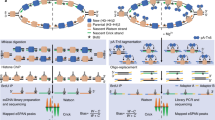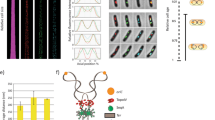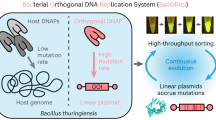Abstract
AN early step in the dark repair of ultra-violet damaged DNA in bacteria is the excision of the damaged single strand regions1,2. It has been postulated that a later step involves the replacement of the excised segments with undamaged deoxyribonucleotides, utilizing the complementary base pairing with the intact single strand1,2. Direct physical evidence for this repolymerization step has been obtained in our laboratory employing the procedure of DNA density labelling with 5-bromouracil and density distribution analysis in caesium chloride density gradients3 to distinguish semiconservative replication from the non-conservative mode of repair replication4. This non-conservative replication has been observed in bacteria after treatment with ultra-violet4, nitrogen mustard5, nitrosoguanidine (unpublished work of E. Cerda-Olmedo and P. C. Hanawalt), or thymine starvation6. The belief that this is the postulated repair synthesis step is strengthened by the results of a number of control experiments as follows. Non-conservative DNA replication is not observed in bacteria in which ultra-violet induced pyrimidine dimers have been repaired in situ by photo-reactivating conditions before density labelling4. It is not observed after ultra-violet irradiation of a strain, E. coli BS–1, sensitive to ultra-violet light which is unable to perform the excision step in the repair sequence7. Non-conservative replication has also been demonstrated by the use of deuterium oxide and nitrogen-15 as density labels to prevent possible artefacts caused by the pathogenicity of 5-bromouracil8. We report here an additional control experiment which demonstrates that the DNA molecules damaged by ultra-violet irradiation which have undergone non-conservative replication are then capable of normal semiconservative replication.
This is a preview of subscription content, access via your institution
Access options
Subscribe to this journal
Receive 51 print issues and online access
$199.00 per year
only $3.90 per issue
Buy this article
- Purchase on SpringerLink
- Instant access to full article PDF
Prices may be subject to local taxes which are calculated during checkout
Similar content being viewed by others
References
Setlow, R. B., and Carrier, W. L., Proc. U.S. Nat. Arad. Sci., 51, 226 (1964).
Boyce, R. P., and Howard-Flanders, P., Proc. U.S. Nat. Acad. Sci., 51, 293 (1964).
Meselson, M., and Stahl, F. W., Proc. U.S. Nat. Acad. Sci., 44, 671 (1958).
Pettijohn, D. E., and Hanawalt, P. C., J. Mol. Biol., 9, 395 (1964).
Hanawalt, P. C., and Haynes, R. H., Biochem. Biophys. Res. Commun., 19, 462 (1965).
Pauling, C., and Hanawalt, P. C., Proc. U.S. Nat. Acad. Sci., 54, 1728 (1965).
Hanawalt, P. C., and Pettijohn, D. E., in Recent Progress in Photobiology (edit. by Bowen, E. J.), 82 (Blackwell, Oxford, 1965).
Pauling, C., and Hanawalt, P. C. (to be published).
Hanawalt, P. C., Nature, 198, 286 (1963).
Maaløe, O., and Hanawalt, P. C., J. Mol. Biol., 3, 144 (1961).
Hanawalt, P. C., Photochem. Photobiol., 5, 1 (1966).
Smith, B. J., J. Mol. Biol., 20, 21 (1966).
Hanawalt, P. C., Maaløe, O., Cummings, D. J., and Schaechter, M., J. Mol. Biol., 3, 156 (1961).
Hackett, P., and Hanawalt, P., Biochim. Biophys. Acta, 123, 356 (1966).
Author information
Authors and Affiliations
Rights and permissions
About this article
Cite this article
HANAWALT, P. Normal Replication of DNA after Repair Replication in Bacteria. Nature 214, 269–270 (1967). https://doi.org/10.1038/214269a0
Issue date:
DOI: https://doi.org/10.1038/214269a0



